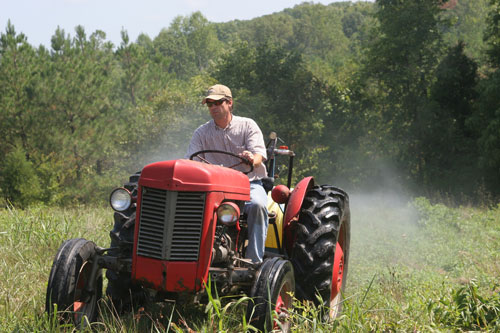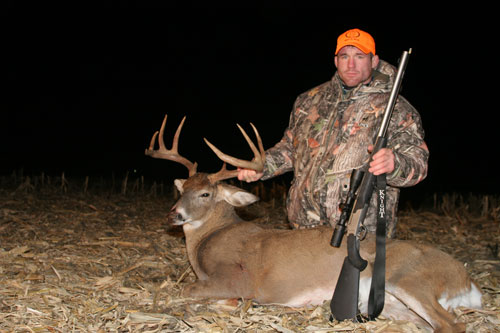
Sure, Miller has killed some decent whitetails during the last 16 years, and he’s been actively planting and managing clover, wheat, chicory and a variety of other food-plot plants on his land all along. He enjoys planting wildlife foods, but even he sometimes wonders if they are worth the time and effort. So do many other hunters.
“I can’t honestly say I’ve seen bigger bucks or even more deer on my farm since I started planting food plots 16 years ago,” he says.
While Miller’s success (or lack thereof) with quality whitetails isn’t necessarily a reflection on the net effect of food plots, it does offer a telling picture of the ups and downs of planting and maintaining them. In other words, planting some clover, wheat or chicory doesn’t automatically guarantee that you’ll kill bigger bucks or even see more deer. In fact, a variety of factors that you can’t control can dictate not just the quality of antlers on your local bucks, but the overall numbers of deer. Now that the food-plot craze has had a chance to settle into a steady, stable industry that has been woven into the deer-hunting culture, some hunters are beginning to wonder if food plots are actually worth it.
Money Matters
Bottom line? Food plots can be pretty darn expensive. Even with gas prices down from last year’s peak, the overall cost of planting and maintaining a healthy stand of clover, wheat or brassicas can add up to a sizeable chunk of money. Last year, when regular gas was shooting up toward $4 a gallon, Miller spent about $400 on gasoline for his equipment to plant about six acres of plots. The seed alone can cost upward of a hundred dollars an acre — more if you use premium designer seed. Miller paid close attention to his bottom line, but he still spent nearly $400 on seed alone. Even wheat, the cheapest all-purpose food-plot seed, has increased in price dramatically in the last few years. What once cost about 8 or 10 dollars for a 50-pound bag of seed has increased to about twice that.
No matter what you plant, the seed is likely the least expensive part of any food plot, even if you choose a premium name-brand product that has pictures of giant bucks on the front of the bag. To grow healthy plots, you’ll need to fertilize them twice a year, and in many regions, it’s critical to spread a heavy dose of lime on the soil. You’ll also need to manage weeds, probably with a herbicide. If you don’t tend your plants and give them exactly what they need, why bother growing food plots at all?
Along with just about everything else, the price of fertilizer has gone through the roof. According to a report by the National Agricultural Statistics Service, the cost of a ton of fertilizer has doubled in the past few years. The higher prices are a result not only of higher fuel prices, but increased demand from developing countries such as China and India, which are using more advanced farming practices. The increase in fertilizer prices forced Miller to cut his usual dosage dramatically. Although many wildlife mangers would say fertilizer is the last thing anyone should scrimp on, it was one expense Miller could do without.
“I’ve been doing this for sixteen years now, and I always have to have gas for my tractor and seed to put in the ground, but this year I had to watch my bottom line somewhere and cutting back a little on fertilizer seemed like the obvious choice,” he says. “I can’t say I’ve noticed a huge difference in the health of the plants or the number of deer using the plots.”
The Labor Factor

When you put it all on paper and take a hard look at the numbers, it just might make more sense to take an annual trip to some distant deer destination such as Iowa, Kansas or even Saskatchewan. If your goal is to shoot a Boone & Crockett buck, that might be a better option. Think about it: A guided hunt in Iowa or Illinois is about $3,000, plus the requisite costs of airfare, licenses and incidentals such as tips and miscellaneous expenses. You certainly won’t spend that much on a food plot, unless, of course, you haven’t bought an ATV or tractor and the necessary implements yet. But you can easily drop a thousand dollars — a hefty sum and a pretty good down payment on an incredible week-long trophy whitetail hunt — on all the necessary ingredients to grow and maintain a couple of average-sized food plots.
Of course, if you don’t have a tractor or ATV, you’ll need one. ATVs can do a decent job on small plots in softer soil, but a tractor is necessary for bigger game patches or if the soil is tough to cut. Even a decent used tractor can set you back several thousand dollars, and a new one can cost as much as a new car. You’ll need a sprayer to kill weeds, a disk or tiller to turn the soil and a spreader to distribute the seed evenly. You should have a mower, as well, because even with a regular spraying schedule, food plots need to be mowed now and then. And then there’s no guarantee they’ll grow.
“We’ve had several dry years and my food plots just didn’t do well at all during those dry years,” notes Miller. “I’d say I’ve had a couple of really good years where my plots grew real well out of the 16 that I’ve lived here. It just depends on the rainfall, and we don’t seem to get much rain in the summer anymore.”
Stay tuned for Part II!






